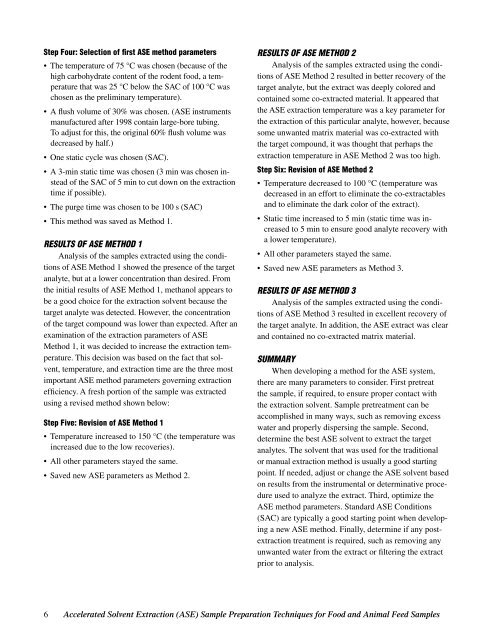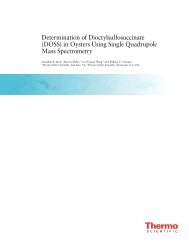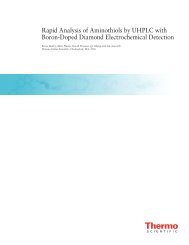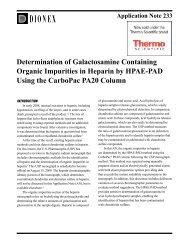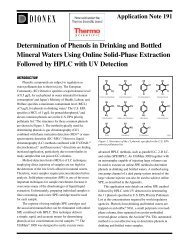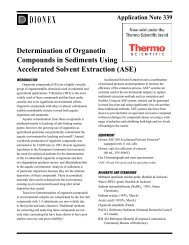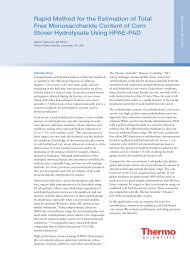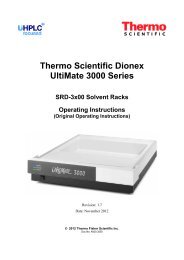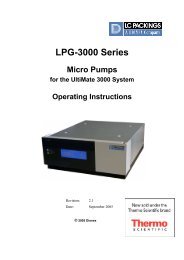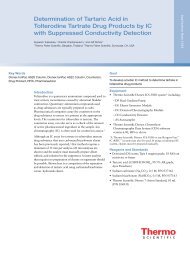Accelerated Solvent Extraction (ASE) Sample Preparation ... - Dionex
Accelerated Solvent Extraction (ASE) Sample Preparation ... - Dionex
Accelerated Solvent Extraction (ASE) Sample Preparation ... - Dionex
You also want an ePaper? Increase the reach of your titles
YUMPU automatically turns print PDFs into web optimized ePapers that Google loves.
Step Four: Selection of first <strong>ASE</strong> method parameters<br />
• The temperature of 75 °C was chosen (because of the<br />
high carbohydrate content of the rodent food, a temperature<br />
that was 25 °C below the SAC of 00 °C was<br />
chosen as the preliminary temperature).<br />
• A flush volume of 30% was chosen. (<strong>ASE</strong> instruments<br />
manufactured after 998 contain large-bore tubing.<br />
To adjust for this, the original 60% flush volume was<br />
decreased by half.)<br />
• One static cycle was chosen (SAC).<br />
• A 3-min static time was chosen (3 min was chosen instead<br />
of the SAC of 5 min to cut down on the extraction<br />
time if possible).<br />
• The purge time was chosen to be 00 s (SAC)<br />
• This method was saved as Method .<br />
ResUlTs OF ase meThOD 1<br />
Analysis of the samples extracted using the conditions<br />
of <strong>ASE</strong> Method showed the presence of the target<br />
analyte, but at a lower concentration than desired. From<br />
the initial results of <strong>ASE</strong> Method , methanol appears to<br />
be a good choice for the extraction solvent because the<br />
target analyte was detected. However, the concentration<br />
of the target compound was lower than expected. After an<br />
examination of the extraction parameters of <strong>ASE</strong><br />
Method , it was decided to increase the extraction temperature.<br />
This decision was based on the fact that solvent,<br />
temperature, and extraction time are the three most<br />
important <strong>ASE</strong> method parameters governing extraction<br />
efficiency. A fresh portion of the sample was extracted<br />
using a revised method shown below:<br />
Step Five: Revision of <strong>ASE</strong> Method 1<br />
• Temperature increased to 50 °C (the temperature was<br />
increased due to the low recoveries).<br />
• All other parameters stayed the same.<br />
• Saved new <strong>ASE</strong> parameters as Method 2.<br />
ResUlTs OF ase meThOD 2<br />
Analysis of the samples extracted using the conditions<br />
of <strong>ASE</strong> Method 2 resulted in better recovery of the<br />
target analyte, but the extract was deeply colored and<br />
contained some co-extracted material. It appeared that<br />
the <strong>ASE</strong> extraction temperature was a key parameter for<br />
the extraction of this particular analyte, however, because<br />
some unwanted matrix material was co-extracted with<br />
the target compound, it was thought that perhaps the<br />
extraction temperature in <strong>ASE</strong> Method 2 was too high.<br />
Step Six: Revision of <strong>ASE</strong> Method 2<br />
• Temperature decreased to 00 °C (temperature was<br />
decreased in an effort to eliminate the co-extractables<br />
and to eliminate the dark color of the extract).<br />
• Static time increased to 5 min (static time was increased<br />
to 5 min to ensure good analyte recovery with<br />
a lower temperature).<br />
• All other parameters stayed the same.<br />
• Saved new <strong>ASE</strong> parameters as Method 3.<br />
ResUlTs OF ase meThOD 3<br />
Analysis of the samples extracted using the conditions<br />
of <strong>ASE</strong> Method 3 resulted in excellent recovery of<br />
the target analyte. In addition, the <strong>ASE</strong> extract was clear<br />
and contained no co-extracted matrix material.<br />
sUmmaRy<br />
When developing a method for the <strong>ASE</strong> system,<br />
there are many parameters to consider. First pretreat<br />
the sample, if required, to ensure proper contact with<br />
the extraction solvent. <strong>Sample</strong> pretreatment can be<br />
accomplished in many ways, such as removing excess<br />
water and properly dispersing the sample. Second,<br />
determine the best <strong>ASE</strong> solvent to extract the target<br />
analytes. The solvent that was used for the traditional<br />
or manual extraction method is usually a good starting<br />
point. If needed, adjust or change the <strong>ASE</strong> solvent based<br />
on results from the instrumental or determinative procedure<br />
used to analyze the extract. Third, optimize the<br />
<strong>ASE</strong> method parameters. Standard <strong>ASE</strong> Conditions<br />
(SAC) are typically a good starting point when developing<br />
a new <strong>ASE</strong> method. Finally, determine if any post-<br />
extraction treatment is required, such as removing any<br />
unwanted water from the extract or filtering the extract<br />
prior to analysis.<br />
6 <strong>Accelerated</strong> <strong>Solvent</strong> <strong>Extraction</strong> (<strong>ASE</strong>) <strong>Sample</strong> <strong>Preparation</strong> Techniques for Food and Animal Feed <strong>Sample</strong>s


